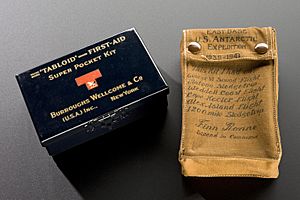United States Antarctic Service Expedition facts for kids
The United States Antarctic Service Expedition (1939–1941) was a big adventure to the icy continent of Antarctica. It's often called Byrd’s Third Antarctic Expedition because Richard E. Byrd led it. This trip was supported by the U.S. government, including the United States Navy and other departments. Many private people and companies also helped by giving money and supplies.
Contents
About the Expedition
Getting Ready and What They Wanted to Do
Rear Admiral Richard E. Byrd gave a lot of the gear for the trip. The biggest gift was a ship called the Bear of Oakland, which became the USS Bear (AG-29). Another ship, the USMS North Star, a strong wooden ice ship, was provided by the government.
A total of 125 men left the United States on these two ships. Most of them were from the military, government jobs, or science groups. Some volunteers worked for a small amount of money, plus food and clothes. Fifty-nine men stayed in Antarctica through the winter, split into three groups.
President Franklin D. Roosevelt gave the team their main goals on November 25, 1939. He wanted them to set up two main bases:
- East Base: Near Charcot Island or Alexander I Land, or in Marguerite Bay.
- West Base: Near King Edward VII Land, or at Bay of Whales near Little America.
They also needed to map the coastline between certain longitudes. It's amazing that they achieved most of these goals, even with all the challenges in Antarctica!
The expedition even brought a light tank and a carrier vehicle. They worked well but were too heavy for the snowy land, so they were left behind.
Cool Discoveries and Events
The expedition used a special vehicle called the Antarctic Snow Cruiser. It was a very creative idea with many new features. However, it didn't work as well as hoped in the tough Antarctic conditions and was eventually left behind. It was found again in 1958, but it's now thought to be lost because the ice it was on broke apart and melted.
The team studied many different things. They looked at earthquakes (seismic), space rays (cosmic ray), the northern lights (auroral), plants and animals (biological), ocean tides, Earth's magnetic field, and how the human body reacted to the cold (physiological). Overall, it was a very successful trip for science!
Ending the Mission
As tensions grew around the world (leading to World War II), it was decided to bring everyone home instead of sending new people to continue the bases. They hoped to come back one day, so much of the equipment and supplies were left behind. The two ships left West Base on February 1, 1941. The East Base was cleared out on March 22, and both ships sailed away. The USMS North Star arrived in Boston on May 5, and the USS Bear on May 18.
Later, in 1945, the U.S. government decided to give special medals (gold, silver, and bronze) to the members of this expedition. This was to thank them for their important work in exploring the polar regions and doing science for the country.
Key Expedition Members
Many brave people were part of this important expedition. Here are a few of the key members:
- Richard E. Byrd: He was a Rear Admiral and the leader of the whole expedition.
- Richard Black: He was the commander of the East Base.
- Richard H. Cruzen: He was the commanding officer of the USS Bear ship.
- George J. Dufek: He was the navigator on the USS Bear.
- Finn Ronne: He was the Chief of Staff and transportation engineer for the East Base.
- Paul Siple: He was a well-known scientist and explorer on the expedition.
Many other scientists, sailors, and volunteers played vital roles in making the expedition a success.
Images for kids



